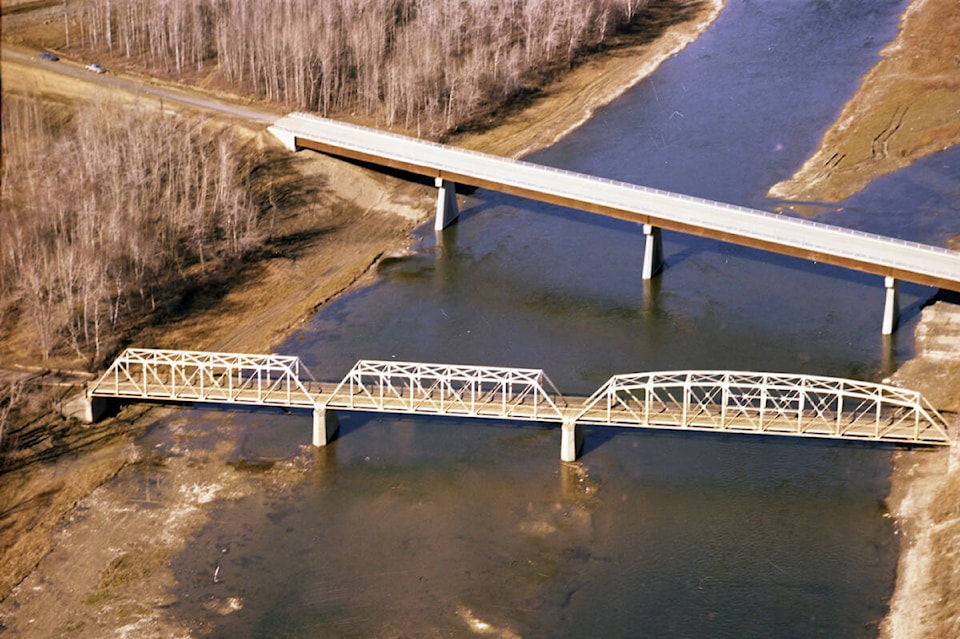This year marks the centennial of a development which helped to confirm Red Deer’s position as the trade and commercial centre for Central Alberta. That was the completion, in July 1922, of the East (Joffre) Bridge which connected Red Deer to the Joffre area to the northeast of the river.
Before bridges were built, the rivers and streams were barriers to travel. They were often unsafe to cross particularly in times of flood, if not impossible to cross during fall freeze-up and spring break-up.
The first bridge across the Red Deer River in Central Alberta was built in 1890-1891 with the construction of the Calgary-Edmonton rail bridge. That was followed starting in 1894 by a series of traffic bridges connecting Gaetz Avenue with the northside of the river.
However, as Central Alberta begin to fill up with settlers, many newcomers faced long detours to reach the bridge if they had to head to town for mail and supplies. That was particularly true of the area northeast of the river, which was reasonably close to Red Deer, but difficult to travel back and forth due to the extra distance to reach either the Red Deer traffic bridge or the Content Bridge north of Delburne.
For many years, there was a lot of pressure placed on the Provincial Government to build a traffic bridge between Red Deer and Content. However, very little happened in response to those lobbying efforts.
Then in February 1921, the Red Deer M.L.A., John Jost Gaetz announced that the Province had decided to build a traffic bridge across the river to more directly connect Red Deer to the rich farming areas to the northeast. It was probably coincidental that a provincial election was pending in the summer of 1921.
There was considerable excitement over the announcement. Not only would there be a much-improved connection between Red Deer and rural areas on the northside of the river, but also there would be a number of new jobs, at a time that the area was still suffering from high unemployment due to the post- First World War economic depression.
Despite the excitement, the Government lost the election and both the Red Deer and Lacombe constituencies. However, the new Government and M.L.A.’s, George Wilbert Smith and Hon. Irene Parlby (the first woman cabinet member in Alberta) indicated that the bridge project would go ahead.
There was still controversy over the location of the bridge. The Government paid for the bridge itself, but not the roads leading to it. The rural municipality (M.D. of Pine Lake) to the south wanted the location at Erickson’s Crossing, as the approach road would be cheaper. However, the one to the north (M.D. of Crown) wanted Kaiser’s Crossing as the distance to Red Deer would be shorter.
The northside prevailed. Through the fall, gravel and supplies were hauled in for the bridge construction while roadwork on the approaches commenced. Over the winter, the bridge supports were constructed and the steelwork installed. The winter was relatively mild, so the project proceeded on budget and ahead of schedule.
Everything was pretty much finished up by late spring. A decision was made to officially open the bridge with a grand picnic and sports day on Wednesday, July 5, 1922. More than 1000 people, from the north and south sides, Red Deer, Lacombe and Clive, turned out for the event.
The weather was good. Dignitaries from the surrounding communities and provincial government gave the usual speeches of well wishes and congratulations. One dignitary who was absent was the Hon. Irene Parlby as there had been a mix-up with her invitation.
One part of the program that had to be scrubbed was a community dance on the bridge in the evening. Too many people wanted to drive over the bridge to make such a gathering safe and practical.
Overall, the bridge was a great success. Its value was even more proven in the 1950s when the extensive Joffre oil and gas fields opened up. In the late 1970s, with the construction of the world scale petrochemical plants near Joffre, a new traffic bridge was constructed to replace the old one which was now too small for the traffic expected on it.
Michael Dawe is a Red Deer Historian and his column appears on Wednesdays.
